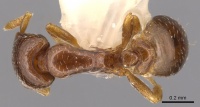Strumigenys prex
| Strumigenys prex | |
|---|---|

| |
| Scientific classification | |
| Kingdom: | Animalia |
| Phylum: | Arthropoda |
| Class: | Insecta |
| Order: | Hymenoptera |
| Family: | Formicidae |
| Subfamily: | Myrmicinae |
| Tribe: | Attini |
| Genus: | Strumigenys |
| Species: | S. prex |
| Binomial name | |
| Strumigenys prex (Bolton, 2000) | |
Known from dozens of litter-sample collections in mesic forest habitats.
Identification
Bolton (2000) - A member of the azteca-complex in the Strumigenys excisa-group. S. prex is the smallest known member of the azteca-complex (compare measurements) and the only one to lack hairs at the pronotal humeri. Perhaps because of this the humeri in dorsal view are smoothly and evenly rounded, whereas in all other known species of the complex the humeri are bluntly and obtusely, but quite definitely, angled.
Keys including this Species
Distribution
Latitudinal Distribution Pattern
Latitudinal Range: 17.5155524° to 17.1212917°.
| North Temperate |
North Subtropical |
Tropical | South Subtropical |
South Temperate |
- Source: AntMaps
Distribution based on Regional Taxon Lists
Neotropical Region: Belize (type locality), Guatemala, Mexico.
Distribution based on AntMaps
Distribution based on AntWeb specimens
Check data from AntWeb
Countries Occupied
| Number of countries occupied by this species based on AntWiki Regional Taxon Lists. In general, fewer countries occupied indicates a narrower range, while more countries indicates a more widespread species. |

|
Estimated Abundance
| Relative abundance based on number of AntMaps records per species (this species within the purple bar). Fewer records (to the left) indicates a less abundant/encountered species while more records (to the right) indicates more abundant/encountered species. |

|
Biology
Castes
Nomenclature
The following information is derived from Barry Bolton's Online Catalogue of the Ants of the World.
- prex. Pyramica prex Bolton, 2000: 174 (w.) BELIZE. Combination in Strumigenys: Baroni Urbani & De Andrade, 2007: 126
Unless otherwise noted the text for the remainder of this section is reported from the publication that includes the original description.
Description
Worker
Holotype. TL 1.7, HL 0.44, HW 0.34, CI 77, ML 0.07, MI 16, SL 0.18, SI 53, PW 0.21, AL 0.45. Dorsolateral margins of head in full-face view slightly constricted at about the midlength, the upper scrobe margins shallowly convex in front of the constriction and the remainder of the margin shallowly convex behind it. Ventrolateral margin of head narrowly high arched in front of the eye, the arch filled in by a thin cuticular lamina. Standing pilosity absent from head and alitrunk; dorsolateral margins of head without projecting hairs and pronotal humeral hairs absent. Waist segments each with 1-2 pairs of short standing hairs and first gastral tergite with one (or perhaps 2) pairs of short hairs laterobasally. Alitrunk unsculptured. Pronotal humeri in dorsal view broadly and evenly rounded, not at all angular. Base of first gastral tergite with very fine feeble longitudinal costulate sculpture. Petiole node in dorsal view broader than long. Lateral lobes of waist segments reduced to small posteriorly curved thorns. With gaster in profile outline of first sternite shallowly convex until very close to the base.
Paratypes. TL 1.7-1.8, HL 0.46, HW 0.35-0.37, CI 76-80, ML 0.08, MI 17, SL 0.18-0.20, SI 53-54, PW 0.22-0.24, AL 0.45-0.48 (2 measured).
Type Material
Holotype worker, Belize (Brit. Honduras on data label): Belmopan, 7.viii.1972, B-244, 2 gr. Cecropia – palm forest, berlese (S. & J. Peck) (Museum of Comparative Zoology). Paratypes. 3 workers with same data as holotype (MCZ, The Natural History Museum).
References
- Baroni Urbani, C. & De Andrade, M.L. 2007. The ant tribe Dacetini: limits and constituent genera, with descriptions of new species. Annali del Museo Civico di Storia Naturale “G. Doria”. 99:1-191.
- Bolton, B. 2000. The ant tribe Dacetini. Memoirs of the American Entomological Institute. 65:1-1028. (page 174, worker described)
References based on Global Ant Biodiversity Informatics
- Bolton, B. 2000. The Ant Tribe Dacetini. Memoirs of the American Entomological Institute 65
- Branstetter M. G. and L. Sáenz. 2012. Las hormigas (Hymenoptera: Formicidae) de Guatemala. Pp. 221-268 in: Cano E. B. and J. C. Schuster. (eds.) 2012. Biodiversidad de Guatemala. Volumen 2. Guatemala: Universidad del Valle de Guatemala, iv + 328 pp
- Dattilo W. et al. 2019. MEXICO ANTS: incidence and abundance along the Nearctic-Neotropical interface. Ecology https://doi.org/10.1002/ecy.2944
- Fernández, F. and S. Sendoya. 2004. Lista de las hormigas neotropicales. Biota Colombiana Volume 5, Number 1.
- Longino J. T. L., and M. G. Branstetter. 2018. The truncated bell: an enigmatic but pervasive elevational diversity pattern in Middle American ants. Ecography 41: 1-12.

